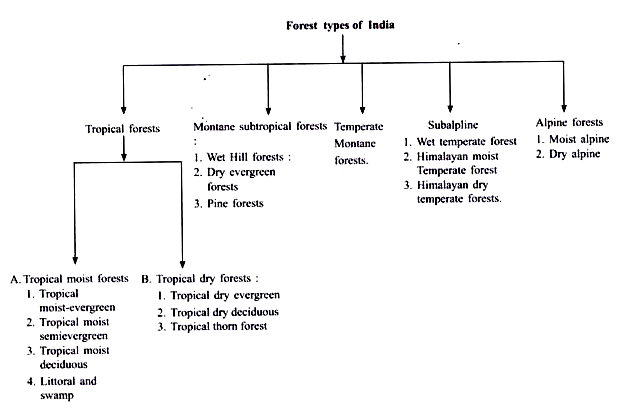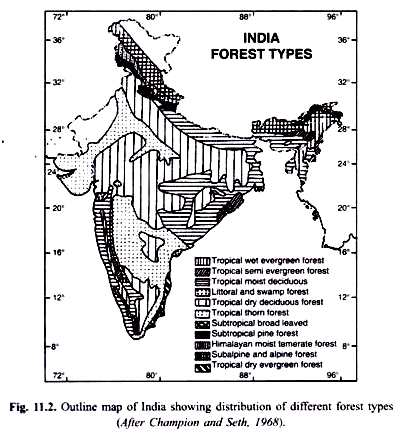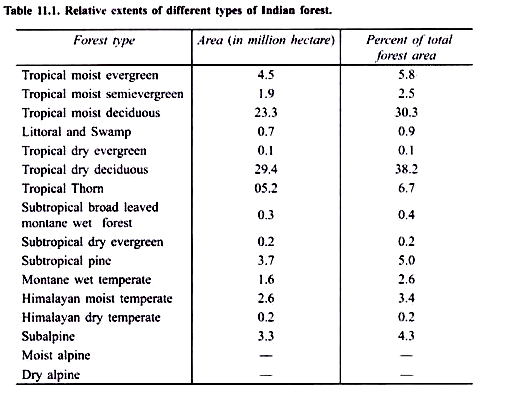Champion (1936) recognized 13 major types of forest in India. Champion and Seth (1968) recognized sixteen types of forest which are listed below. (Fig 11.2).
Hanson (1962) defines forest as “a stand of trees growing close together with associated plants of various kinds”.
The following types of forests are found in India which cover nearly 17 per cent of the total area of Indian territory.
 The relative extents of different types of forests in India are presented in the following Table 11.1.
The relative extents of different types of forests in India are presented in the following Table 11.1.
I. Tropical forest:
A great majority of the forests found in India are of this type. Tropical forests are of two types:
(A) Tropical moist forests.
(B) Tropical dry forests.
A. Tropical moist forests:
These are further classified into the following types on the basis of relative degree of wetness:
(i) Tropical moist evergreen forests,
(i) Tropical moist semi-evergreen forests, and
(iii) Tropical moist deciduous forests.
(iv) Littoral and swamp forests.
(i) Tropical moist evergreen forests:
These are also called tropical rain forests. In India such forests are found in very wet regions receiving more than 250 cm average annual rainfall. These are climatic forests having luxuriantly growing lofty trees which are more than 45 metres in height. The shrubs, lianas (woody climbers) and epiphytes are abundant because of high rainfall. These forests are found in Andaman and Nicobar Islands, Western coasts and parts of Karnataka (N. Canara), Annamalai hills (Koorj), Assam and Bengal. The detail account of this is given in the description of mesophytes.
(ii) Tropical moist semi-evergreen forests:
These forests are found along the western coasts, eastern Orissa and upper Assam where annual rainfall is between 200 and 250 cm. They are characterised by giant and luxuriantly growing intermixed deciduous and evergreen species of trees and shrubs. The important plants in these forests are the species of Terminalia, Bambusa, Ixora, Dipterocarpus, Garcinia, Sterculia, Mallotus, Calamus, Albizzia, Elettaria, Pothos, Vitis, Shorea, Cinnamomum, Bauhinia, Albizzia, etc. Orchids, ferns, some grasses and several other herbs are also common.
(iii) Tropical moist deciduous forests:
These cover an extensive area of the country receiving sufficiently high rainfall (100 to 200 cm) spread over most of the year. The dry periods are of short duration. Many plants of such forests show leaf-fall in hot summer.
The forests are found along the wet western side of the Deccan plateau, i.e. Mumbai, N-E. Andhra, Gangetic plains and in some Himalayan tracts extending from Punjab in west to Assam valley in the east. The forests of Southern India are dominated by Teak (Tectona grandis), Terminalia paniculata, T. bellerica, Grewia tilliaefolia, Dalbergia latifolia, Lagerstroemia, Adina cordifolia, etc. are the other common species in forests of South India. In north, they are dominated by shal (Shorea robusta).
Some other common associates of shal are Terminalia tomentosa, Dellenia species, Eugenia species, Boswellia species and Mallotus philippensis. These forests produce some of the most important timbers of India. Grasses become important both in seral stages and in the areas under fire.
(iv) Littoral and Swamp Forests:
Littoral and Swampy forests include the following types:
(1) Beach forests
(2) Tidal forests or Mangrove forests
(3) Fresh water swamp forests.
Beach Forests:
The beach forests are found all along the sea beaches and river deltas. The soil is sandy having large amount of lime and salts but poor in nitrogen and other mineral nutrients. Ground water is brackish, water table is only a few metres deep and rainfall varies from 75 cm to 500 cm depending upon the area. The temperature is moderate. The common plants of these forests are Casuarina equisetifolia, Borassus, Phoenix, Manilkara littoralis, Callophyllum littoralis, Pandanus, Thespesia, Barringtonia, Pongamia, Cocos nucifera, Spinifex littoreus and a number of twiners and climbers.
Tidal or Mangrove forests:
Tidal forests grow near the estuaries or the deltas of rivers, swampy margins of Islands and along sea coasts. The soil is formed of silt, silt-loam or silt-clay and sand. The plants are typical halophytes which are characterised by presence of prop roots with well developed knees for support and pneumatophores and viviparous germination of seeds.
Tidal forests one distinguished into the following four types with overlapping constituent species:
(i) Tree mangrove forests
(ii) Low mangrove forests,
(iii) Salt water forests and
(iv) Brackish water forests.
Tree Mangrove forests:
These forests occur on both east and west sea coasts. The best development occurs in Sundarbans. The forest floor is flooded with salt water daily. Plants may attain a height 10-15 metres and form an almost closed evergreen forests. The common trees of these forests are Rhizophora mucronata, R. conjugata, Avicennia alba, Bruguiera conjugata, B. parviflora, B. caryophylloides, Kandelia candel, Xylocarpus molluccensis, X. granatuns, Ceriops tagal, Avicennia officinalis, Excoecaria agallocha, Sonneratia acida, Lumnitzera racemosa, L. littorea, Aegiceras carniculatum and two most frequently occurring palms; Nipafruticans and Phoenix paludosa. In addition to these trees Acanthus ilicifolius and other shrubs also grow at places.
Low Mangrove Forests:
These forests grow on soft tidal mud near estuaries, which is flooded by salt water. Forest is dense but the trees with leathery leaves attain maximum height of 3-6 m. The vegetation consists of a few species which show gregarious growth habit. Important tree species are Ceriops decandra, Avicennia alba, Aegialitis rotundifolia and Excoecaria agallocha. Besides, a common shrub Acanthus elicifolius and some grasses also occur at places. Low mangrove forests are more developed on east sea coast than on west coast.
Salt water Mangrove Forests:
These forests occur beyond tree mangrove forests in big river deltas where the ground is flooded with tidal water. Silt deposition and salt content in soil are low. Tree height is upto 20 m or so but girth is not large. Forests are dense. Pneumatophores are common. The common plants are Heritiera minor, Excoecaria agallocha, Ceriops decandra, Xylocarpus molluccensis, Bruguiera conjugata, Avicennia officinalis and Nipa at places.
Brackish Water Mangrove Forests:
They grow near the river deltas where forest floor is flooded with water at least for some times daily. Water is brackish (salty) but during rains it is nearly fresh. Tree height may reach 30 m or so. Forest is dense. Common species of the forests are Heritiera minor, Xylocarpus molluccensis, Bruguiera conjugata, Avicennia officinalis, Sonneratia caseolaris, S. acida, Excoecaria agallocha, Ceriops decandra Cynometra ramiflora, Amoora cuculata, Pandanus, and two palms; Nipa and Phoenix paludosa.
Fresh Water Swamp Forests:
These forests grow in low lying areas where rain or swollen river water is collected for some time. Water table is near the surface. Important plants include Salix tetrasperma, Acer, Putranjiva, Holoptelia, Cephalanthus, Barringtonia, Olea, Phoebe, Ficus, Murraya, Adhatoda, Canna and a variety of grasses.
B. Tropical dry forests.
These are classified into the following types:
(i) Tropical dry evergreen forests,
(ii) Tropical dry deciduous forests, and
(iii) Tropical thorn forests.
(i) Tropical dry evergreen forests:
These forests are found in the areas where rainfall is in plenty but dry season is comparatively longer. The trees are dense, evergreen and short (about 10 to 15 metres high). These forests are found in eastern part of Tamil Nadu, in east and west coasts. The common plant species are much the same as in Tropical moist evergreen forests. Species of Maba, Calotropis, Pabatta, Feronia, Canthium, Zizyphus, Randia etc. are most common. Bamboos are absent but grasses are common.
(ii) Tropical dry deciduous forests:
These forests are distributed in the areas where annual rainfall is usually low, ranging between 70 and 100 cm, such as, Punjab, U.P., and Bihar, Orissa, M.P. and large part of Indian peninsula. The largest area of the country’s forest land is occupied by Tropical dry deciduous forests. The dry season is long and most of the trees remain leafless during that season.
The forest trees are not dense, 10 to 15 m in height, and undergrowth is abundant. In north, the forests are dominated by shal and in south by teak (Tectona grandis). The common constituents of these forests in South are Dalbergia, Terminalia, Dillenia, Acacia, Pterospermum, Diospyros, Anogeissus, Boswellia, Chloroxylon, Bauhinia, Hardwickia, Gymnosporia, Zizyphus, Moringa, Dendrocalamus, and so on. The other species of trees and shrubs of Sal dominated forests of northern region are Terminalia, Semicarpus, Buchnania, Carissa, Modhuca, Acacia, Sterculia, Launea, Salmalia Adina, Bauhinia, Aegle, Grewia, Phyllanthus, etc.
(iii) Tropical thorn scrubs:
These forests occur in the areas where annual rainfall is between 20 to 70 cm, dry season is hot and very long. They are found in South Punjab, most of Rajasthan and part of Gujarat. The vegetation in these region occurs only along the rivers. The land away from the rivers and devoid of irrigation is mostly sandy and devoid of trees. The vegetation is of open type consisting of small trees (8 to 10 m high) and thorny or spiny shrubs of stunted growth. The forests remain leafless for most part of the year and are sometimes called thorn scrub or scrub jungles.
There is luxuriant growth of ephemeral herbs and grasses during the rainy season. Towards the desert region the vegetation diminishes and in arid parts there is almost no vegetation. The species of Acacia, Cassia, Calotropis, Randia, Albizzia, Zizyphus, Erythroxylon, Euphorbia, Cordia, Prosopis. Salvadora, Aegle, Gymnosporia, Atriplex, Grewia, Asparagus, Berberis, Butea, Kochia, Leptadenia, Capparis, Adhatoda, etc. characterise the plant formations of semiarid regions of India.
Champion (1938) named the natural vegetation of desert as tropical thorny forest. Bharucha (1955) divided the Rajasthan desert into the following vegetational zones:
(i) Area of shifting sand dunes at and around Jaisalmer and Bikaner.
(ii) Area of established sand dunes near Jodhpur.
(iii) Sand stone rocks covered by xerophytic plants like Euphorbia nerifolia.
(iv) Area of halophytic vegetation.
(v) Sandy-loam soil vegetation.
II. Subtropical montane forests:
These forests are found in the region of fairly high rainfall but where temperature differences between winter and summer are less marked. Winter generally goes without rains. They are found upto the altitude of about 1500 metre in south and up to 1800 metre in the north. In composition, subtropical forests are almost intermediate between tropical forests and temperate forests and a sharp demarcation can seldom be made between tropical and subtropical or subtropical and temperate forests.
These forests have been grouped into the following three types:
(i) Wet hill broad leaved forests,
(ii) Dry evergreen forests, and
(iii) Pine forests.
(i) Wet hill broad leaved forests:
They are found in Mahabaleshwar, Coorg, Karnataka, parts of Assam, Panchmarhi and other parts of M.P. The important plants found in the wet hill forests of south are the species of Eugenia, Randia, Terminalia, Eleganus, Murraya, Gymnosporia, Atylosia, Ficus, Pterocarpus, Lantana, etc. while those of the north are Castonopsis, Calamus, Alnus, Quercus, Betula, Schima phoebe, Cedrella, Garcinia, Populus etc.
(ii) Dry evergreen forests:
They occupy the foot-hill areas of Himalayas. The common constituents of vegetation are Acacia modesta, Olea cuspidata, etc.
(iii) Pine forests:
They are found mostly in western and central Himalayas and in Assam hills. The forests are dominated by species of Pinus (Pinus khasya and P. roxburghii). Species of Quercus, Berberis, Carissa, Bauhinia may also occur rarely in pine forests.
III. Temperate Montane forests:
These forests occur in the Himalayas at the altitude from 1800 to 3800 metres where humidity and temperature are comparatively low.
Montane forests have been classified into the following three types on the basis of moisture regime:
(i) Montane Wet temperate forest,
(ii) Himalayan Moist temperate forest, and
(iii) Himalayan Dry temperate forest
(i) Montane Wet temperate forests:
These are found in Himalayas extending from Nepal to Assam at the altitude from 1800 to 3000 m, as well as in some parts of South India (Nilgiris). The forests in south are evergreen and are called sholas. The forests are dense with closed canopy and the trees may be 15 to 20 m high. Epiphytes are in abundance. Important plants constituting the vegetation in Eastern Himalayas are species of conifers, Hopea, Balanocarpus, Elaeocarpus, Artocarpus, Pterocarpus, Myristica, Hardwickia, Salmelia, Dioscoria. The members of family Compositae, Rubiaceae, Acanthaceae and Leguminosae form the undergrowth.
(ii) Himalayan Moist temperate forests:
These forests develop in the areas of lesser rainfall. The trees are high, sometimes up to 45 metres tall. The dominant elements of vegetation are oak and conifers. Undergrowth is shrubby and consists of deciduous species of Barberis, Spiraea, Cotaneaster, etc.
(iii) Himalayan Dry temperate forests:
These forests dominated by Rhododendrons, oaks and conifers from a narrow belt at the altitude from 3000 to 4000 m in the western Himalayas extending from a part of Uttaranchal through Himachal Pradesh and Punjab to Kashmir. The other commonly found species belong to genera Daphne, Desmodium, Indigofera, Artemisia, Cannabis, Plectranthus, Fraxinus, several epiphytic mosses, Lichens, etc.
IV. Sub-alpine Forests:
The sub-alpine forests are found throughout Himalayas from Ladakh in the west to Arunachal in the east at the altitude from 2800 m to 3800 m. Annual rainfall is less than 65 cm. but snowfall occurs for several weeks in a year. Strong winds and below 0°C temperature prevail for greater part of the year. Trees are like those of temperate zone. Epiphytic mosses and lichens are in abundance.
Champion (1939) has recognized the following two types of forests in sub-alpine zone:
(a) Sliver Fir-Birch forests which are found on glacial moraines. Abies spectabilis, Abies densa, Pinus wallichiana, Betula utilis, Quercus semecarpifolia, Pyrus spp. Rhododendrons, Juniperus recurva, J. wallichiana, Berberis, Salix fruticulosa are common plants of these forests.
(b) Birch-Rhododendron forests which grow on rocky substrata. The common trees are Betula utilis, Quercus semecarpifolia, many species of Rhododendron Pyrus spp. Acer spp, Salix, Juniperus spp etc.
V. Alpine forests:
Alpine vegetation has been classified into the following three types:
(a) Alpine forests,
(b) Moist Alpine scrubs, and
(c) Dry Alpine scrubs.
(a) Alpine forests:
Plants growing at the altitude from 2900 to 6000 m are called alpine plants. In India, alpine flora occurs in Himalayas between 4500 and 6000 metres. At lower level, alpine forests consist of dwarf trees with or without conifers and at higher level scrubs and only scattered xerophytic shrubs are left to merge with alpine meadows. The common plants of alpine forests are Abies, Pinus, Juniperus, Betula, shrubby Rhododendrons, Quercus, Pyrus, Salix etc.
(b) Moist Alpine scrubs:
This type of vegetation is distributed extensively throughout the Himalayas above 3000 metres. It is most often dense and composed of evergreen dwarf Rhododendron species, some birch and other deciduous trees. Mosses and ferns cover the ground with varying amounts of alpine shrubs, flowering herbs and ferns. Alpine pastures include mostly mesophytic herbs with very little grasses.
(c) Dry Alpine scrubs:
These are open xerophytic formations spread in U.P., Himachal Pradesh, Punjab and Kashmir. Species belonging to Artemisia, Potentilla, Kochia, Juniperus predominate in the vegetation which develops generally on lime stone rock.

